The 2024 deadline for certifying the development and maintenance of your affirmative action program via the OFCCP’s web portal is Monday, July 1. In this Q&A with Affirmity’s Manager of Consulting Services, Brad Wiltshire, we answer some common questions about the process, gleaned during the two years since the portal first opened.
Q: Who needs to certify AAP compliance?
Brad Wiltshire: The basic idea is that if you’re a covered federal contractor, you’re now required to certify annually that you’re in compliance with the AAP regulations, and that you develop and maintain your AAPs annually. The thresholds for coverage are:
- Contractors or subcontractors with a contract of $50,000 or more and 50+ employees pursuant to Executive Order 11246 and Section 503 of the Rehabilitation Act of 1973.
- Contractors or subcontractors with a contract of $150,000 or more and 50+ employees must also develop an AAP pursuant to the Vietnam Era Veterans’ Readjustment Assistance Act of 1974 (VEVRAA).
Additionally:
- Contractors with Functional Affirmative Action Plan (FAAP) agreements must also certify.
- Construction contractors who are not also supply and service contractors are not required to register with the portal or certify compliance.
- Despite having a different type of contract arrangement, banking institutions are required to register and certify.
Note that certification does not exempt your organization from compliance evaluations.
Q: What are contractors actually certifying in the portal?
BW: It’s important to underline that contractors aren’t just going in and saying “we’ve done our AAP this year”, i.e. just that they’ve run their analyses, looked at reports, and set goals. The other major component of this is that they’re confirming they’re compliant with all requirements of the affirmative action program.
In practice, you’re asked to choose one of the following three statements describing your organization’s status:
- Your organization has developed and maintained affirmative action programs at each establishment, as applicable, and/or for each functional or business unit.
- Your organization has been party to a qualifying federal contract or subcontract for 120 days or more and has not developed and maintained affirmative action programs at each establishment, as applicable.
- Your organization became a covered federal contractor or subcontractor within the past 120 days and therefore has not yet developed applicable affirmative action programs.
Note that if you’re a new contractor (as per statement number 3), you’ll have an additional 90 days to certify once you’re 120 days into your contract period. The portal is open year-round to facilitate this.
IMPORTANT INFORMATION ON ONE KEY ASPECT OF YOUR AAP | ‘What Are Your Training Obligations As a Federal Contractor?’
Q: How does the certification process actually work?
OFCCP Portal Registration
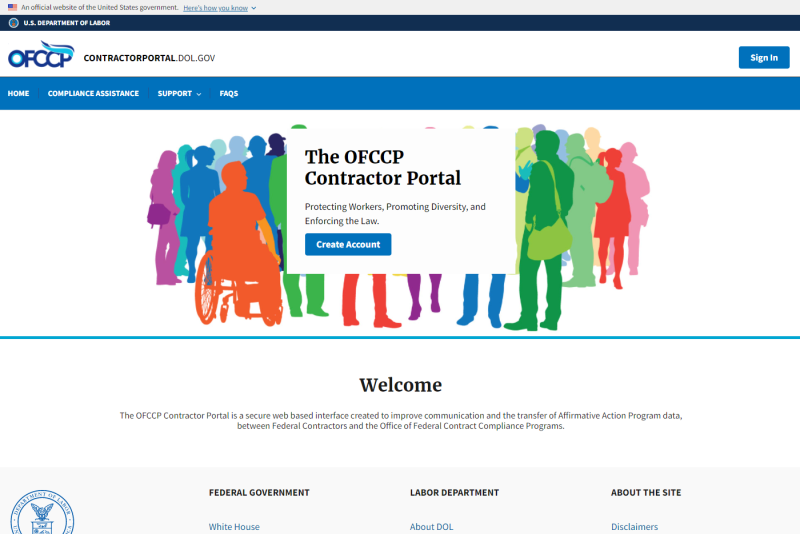
BW: The first step is to register with the OFCCP Contractor Portal if you haven’t done so already. As 2024 is the third year the portal has been in operation, it’s likely that your organization is already registered (unless you’re an entirely new contractor). But regardless, if you need to create an account you should do so with the “Create Account” button on the contractorportal.dol.gov home page.
This process will involve signing in via the Login.gov system so you’ll also need to create a personal Login.gov account if you haven’t got one already.
Logging Into the OFCCP Portal
BW: Once in, you should choose “Get Started” from the welcome screen and agree to the “Rules of Behavior” statement, then you’ll then be asked for a number of unique identifiers to help create your account:
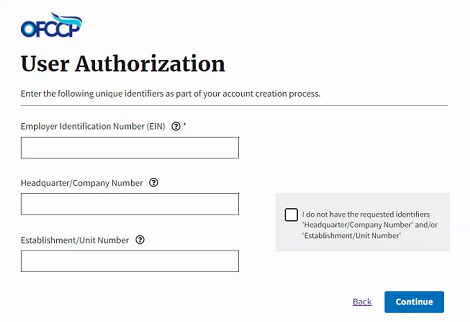
On this user authorization screen you’ll need the following:
- Federal Employer ID Number (EIN)
- EEO-1 Headquarters/Company ID Number—note that this field appears to require only the first six characters of this number, so try this if your full ID isn’t accepted
- EEO-1 Establishment/Unit ID Number if applicable
Organizations that have never filed an EEO-1 should contact the OFCCP’s technical support function. Higher education institutions should use their IPED IDs instead.
Adding and Updating Establishment Information
BW: The EEO-1 (or IPED) identifiers you provide during registration should allow the portal to pre-populate a lot of your information based on previous filings. You should double-check this information and/or provide anything that is missing, especially as it’s not clear from the site whether the portal still uses 2018 EEO-1 data as it has in previous years, or has been updated to use more recent information.
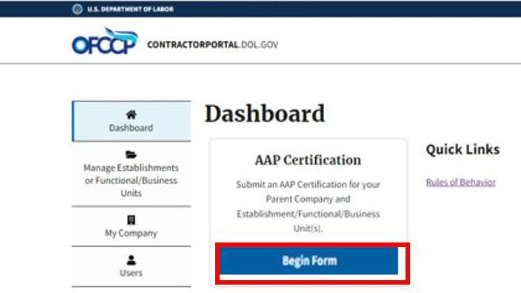
Once logged in, you’ll be presented with the basic portal interface allowing you to edit establishment, company, and user information. Via the “My Company” option, you’ll be able to add or close establishments as necessary. To do this, you’ll need the following information:
- EEO-1 Unit IDs
- North American Industry Classification System (NAICS) codes
- Data Universal Numbering System (DUNS) IDs [optional]
- Federal EIN [optional]
- Establishment names
- Headcounts
- Physical and mailing addresses
- Contact information
If you have 100 or more establishments to load into the system, the OFCCP does offer a bulk upload option. This will require submitting a template via email, and the process is likely to be time-consuming—so make contact with the OFCCP as soon as possible if you need to use this method.
The Certification Form
BW: Returning to the initial menu, the dashboard option will allow you to begin your certification—just click the “Begin Form” button to start.
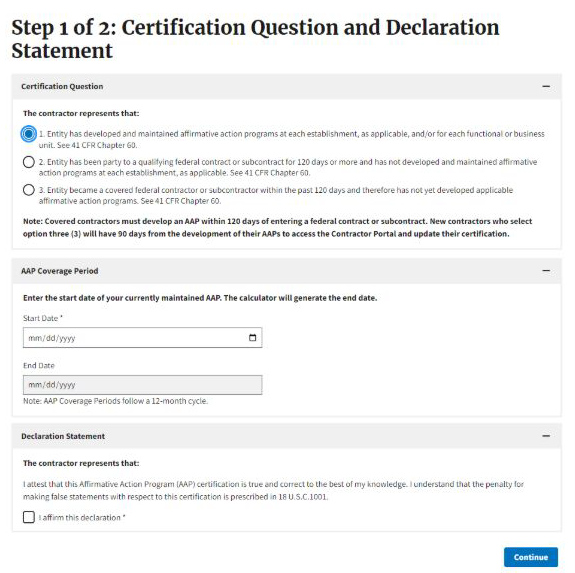
The form will ask you to specify which one of the three certification statements applies to your submission (see the question “What are contractors actually certifying in the portal?” above for more details). You must also specify your AAP coverage period, i.e. your plan start date. The end date will be automatically generated based on the start date you provide. Tick the box affirming the declaration statement to proceed.
On the next page, you’ll be asked which of your establishments or functional business units the certification applies to. You can choose to certify per establishment, or bulk certify for multiple (or all) establishments at once.
YOU MAY ALSO BENEFIT FROM READING | ‘Realistic DE&I Goal Setting: How to Use Data to Get Ahead’
Q: How do you manage users within the portal?
BW: Once you’re logged in, just choose “users” from the main index to access the user management area of the portal. If you’ve got a large program with hundreds of plans, you’ll likely have many different people who’ll help with this process, so you have the ability to add multiple user accounts and give them admin or non-admin access. You’ll also be able to assign establishments or functional/business units to these users within this section.
Bear in mind that whoever creates the initial account is going to be an administrator account for the organization. Therefore, you’ll want to make sure that an appropriate individual is selected to create the account, and that a proper handover of admin access can take place in the event that the initial account owner leaves the business. Losing access to this account may mean losing access to the portal until you can get help from the OFCCP, if no other administrators have been created prior to this individual’s exit.
Q: What plan information do I have to upload to the OFCCP portal?
BW: As of 2024, the portal does not currently ask for, or have any functionality for, uploading any affirmative action plan documentation.
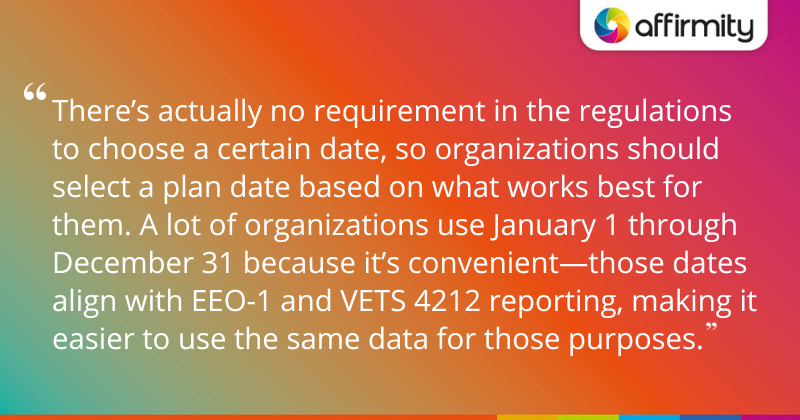
Q: How should my organization develop and maintain its annual affirmative action programs?
BW: Naturally, the goal is to be able to truthfully tick the “Your organization has developed and maintained affirmative action programs at each establishment, as applicable, and/or for each functional or business unit” option in the portal. However, if you’re new to creating AAPs, you may need help understanding what your responsibilities actually are.
Broadly speaking, your responsibilities will include:
- Developing and updating your AAP annually
- Digging into your data and performing all required analyses
- Establishing placement goals and benchmarks, and investigating any problem areas
- Keeping records, reporting, monitoring, and evaluating
- Communicating with the recruiting teams and business leaders and providing training
- Conducting targeted outreach and exploring avenues for recruitment
- Reviewing your personnel processes
- Submitting data in time for various federal and state deadlines
Our blog post ‘A Year in the Life of a Compliance Professional: 7 Key Affirmative Action Responsibilities’ will help you understand each of these responsibilities.
ALSO, GET THIS INFORMATION IN CHECKLIST FORM | ‘Your Annual Affirmative Action Responsibilities: Have You Covered Everything?’
Q: How do organizations select their AAP plan date and what is that based on?
BW: There’s actually no requirement in the regulations to choose a certain date, so organizations should select a plan date based on what works best for them. A lot of organizations use January 1 through December 31 because it’s convenient—those dates align with EEO-1 and VETS 4212 reporting, making it easier to use the same data for those purposes. Others may use dates that align with their fiscal year. Another motivation may be to select a time of year when your teams will have more time to focus on the process (away from other competing deadlines).
The most important thing is to pick a date and remain consistent going forward, changing those dates only for exceptional circumstances. A good example of something that may require a change of plan date is a merger or acquisition with a business that uses a different date. If this happens, you should avoid creating a gap in coverage for the companies involved—overlapping your efforts if necessary.
Q: What should organizations do if they have establishments with fewer than 50 employees?
BW: Some organizations will choose to have a separate AAP for smaller locations, others will instead roll these locations into another facility. You cannot roll a location into any random facility: there needs to be an actual connection between the two. A typical measure would be to place a small location in the AAP for your headquarters or a different facility where the managers of its main function or line of business are located.
Though the threshold for an establishment to have its own AAPs is 50 employees, it’s not unusual to create location-based AAPs for all locations regardless of their employee counts. It may be difficult to action or get results from AAP locations with very small headcounts, however. Organizations will sometimes set a threshold of 30 or 40 employees, with any locations with fewer employees being rolled up into another plan.
Get help with every aspect of your year-round AAP activity and ensure you can certify with confidence: Contact Affirmity today.
About the Author
 Brad Wiltshire is a Manager of Consulting Services at Affirmity. He has 15 years of experience developing Affirmative Action Plans as well as EEO-1, and VETS reports for clients across many industries. A former attorney, Mr. Wiltshire’s legal background has helped him provide ongoing guidance and support for OFCCP audits and other compliance needs. Connect with him on LinkedIn.
Brad Wiltshire is a Manager of Consulting Services at Affirmity. He has 15 years of experience developing Affirmative Action Plans as well as EEO-1, and VETS reports for clients across many industries. A former attorney, Mr. Wiltshire’s legal background has helped him provide ongoing guidance and support for OFCCP audits and other compliance needs. Connect with him on LinkedIn.
